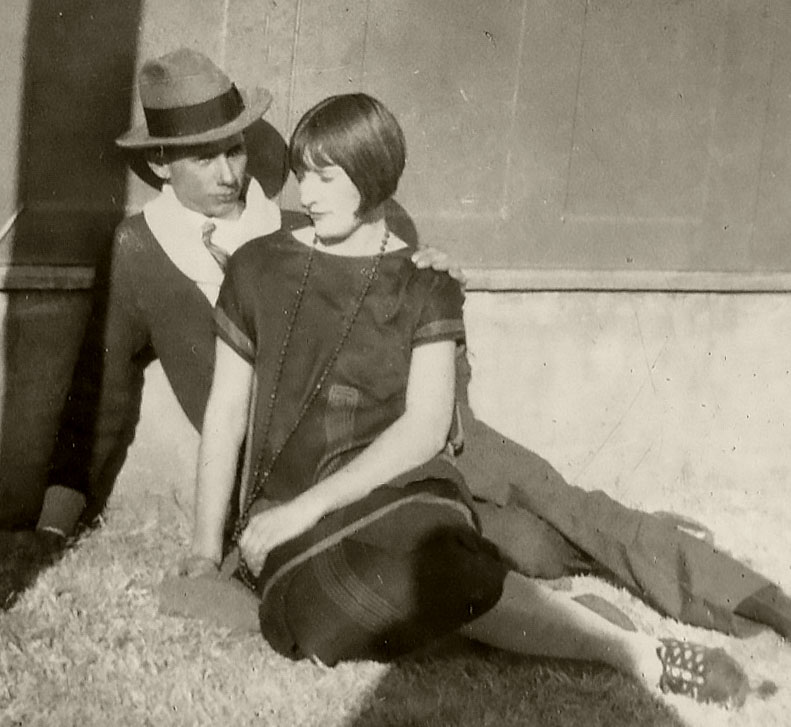
I wish we had the story of how Bill Sinclair and Ina Hammond first laid eyes on each other. But, it isn’t difficult to imagine. It would have been around 1925 and Ina would have been about 22. It was a time of new-found freedom for young women who had just earned the right to vote, were wearing shorter and less restrictive fashions (including bathing costumes!), were able to socialize more easily, and were working outside the home and making some pocket money – at least up until the time they married. Ina had two years of high school (which was considered a lot for girls of that era). She had a steady job working as a clerk in Buster Vaughan’s SpotCash store in Wynnewood, Oklahoma. Her family wasn’t wealthy by any means. Her father, Ellis, farmed for a living, both on property he owned and other farms he managed. Her mother, Fanny, was a homemaker and taught her daughter all of the skills needed to eventually make a home and have a family. But that day was not here yet in the mid-1920’s. Young women now had the freedom to enjoy a single life for a few years between childhood and their weddings. Ina kept a photo album that showed a life full of friends and social activities and this is where we get a real sense of her happy and carefree life. In the newspapers of small town America, it seemed you couldn’t cross the street without it appearing in the “Local Interest” section. And Ina was a regular fixture in the Wynnewood Gazette and New Era Farmer.
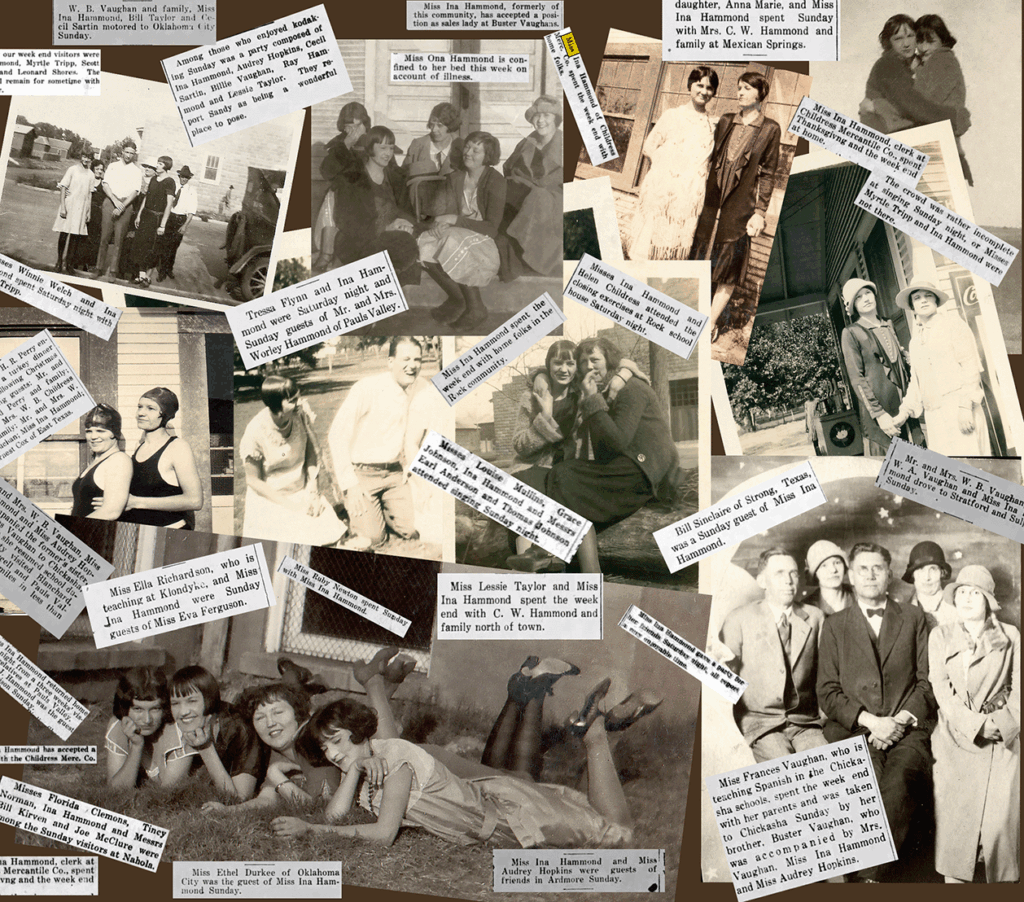
Photos from Ina’s girlhood scrapbook and clippings from the Wynnewood Gazette or New Era Farmer newspapers
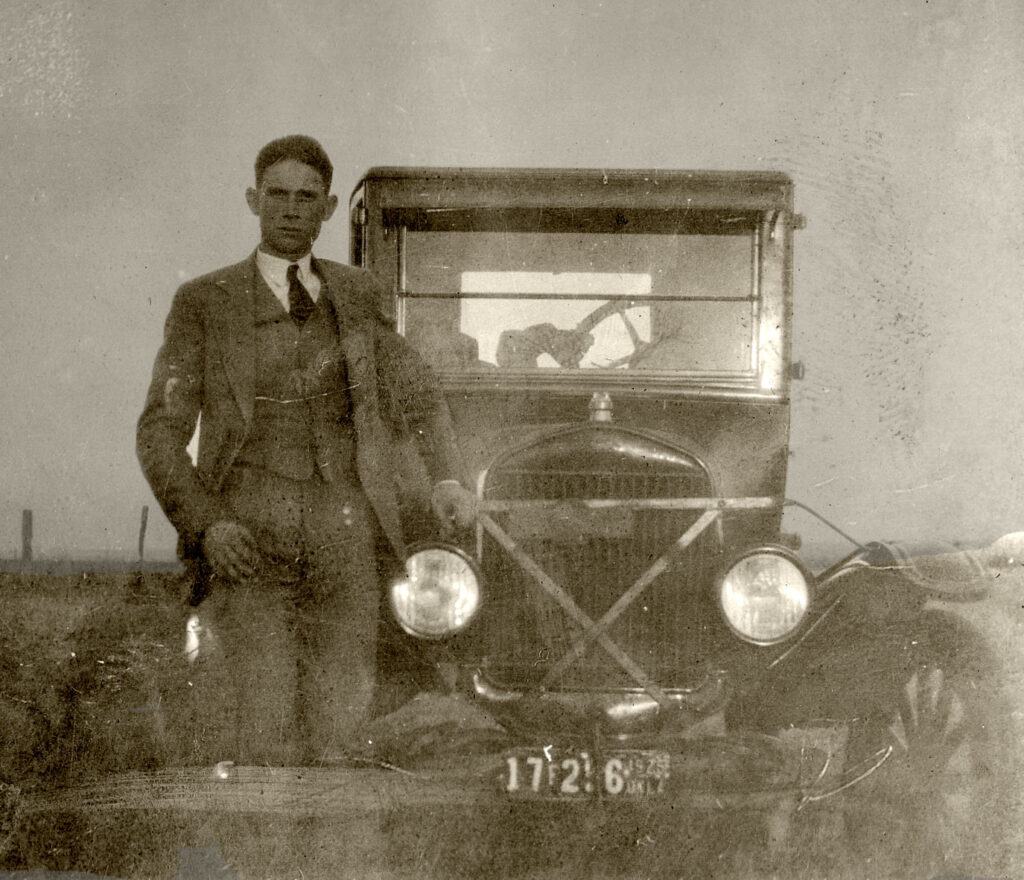
Bill Sinclair, about 24, came to Oklahoma for his work as a pumper and pipeline engineer for Texas Pacific Coal & Oil Company. A new discovery southwest of Wynnewood required production facilities to be built and pipelines to transport the oil to Wynnewood, where there was a railroad depot. He lived in a company “man-camp” with other single oilfield workers probably near tiny Purcell, Oklahoma, and going to town on Friday and Saturday night was probably the highlight of their weeks. These single men with good jobs undoubtedly appeared very attractive to the young ladies in a farming town such as Wynnewood. We know Bill had a car, which was a bonus! He was a catch!
There was plenty to do. This was during Prohibition, but I really doubt if the secret back-alley bars and beer joints had much appeal for Bill and Ina. Bill had joined the Masonic Lodge in Foster, Oklahoma in 1926 and they offered social and civic events for their members. Ina was very involved in the Baptist church and that was a source of social activity in her world. Not to mention that she had a good job working in a retail shop, where she probably met lots of people. In many of the scrapbook photos of Bill and Ina, he is wearing a suit, making me think that a lot of their time together involved church. And she had so many friends. The one letter we have that Ina wrote during this time mentions a picture show on a Saturday night “just to pass time” and a fishing trip to Turner Falls the very next day — “if we can get a bunch together”. In contrast, Bill appeared to be shy and prone to keeping to himself. He doesn’t much care for going to shows and he mentions a barn dance that he could have gone to, “but you know how much I care about anything of that kind”.
So, Bill and Ina met somehow. Family lore has it that Bill was actually first interested in Electa Poe. But Electa got married in 1925, so any interest would have been short-lived. Once Bill and Ina did become a couple, there are a lot of photos of them together. Snapshot photography was such a passion in small town America during this time. And thank heavens for that!
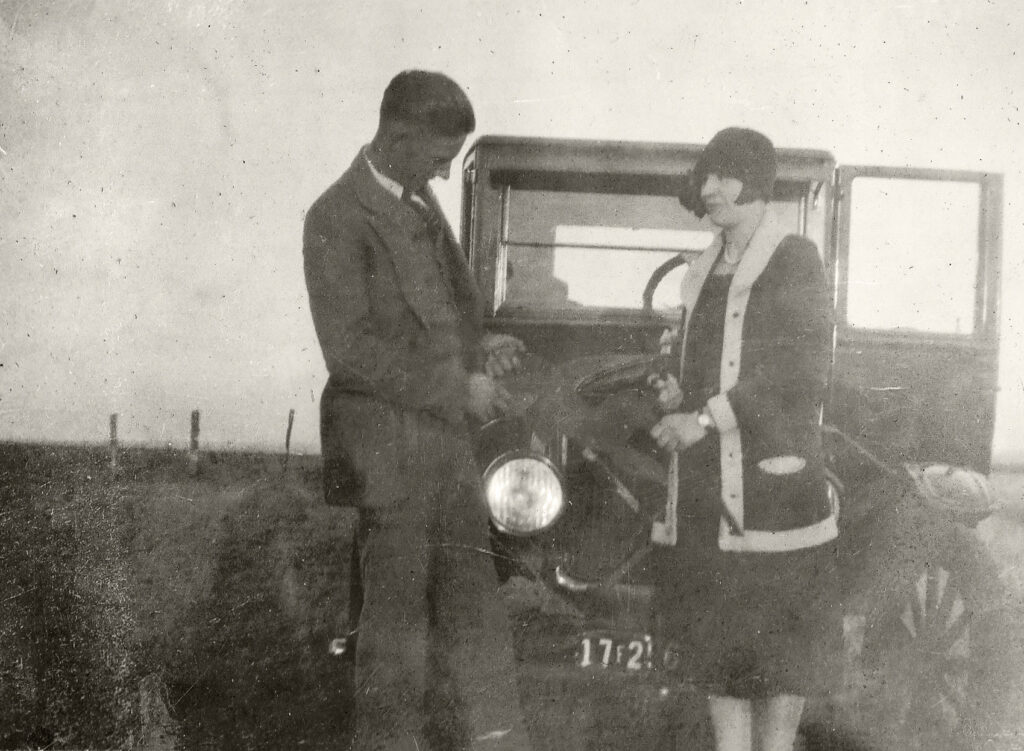
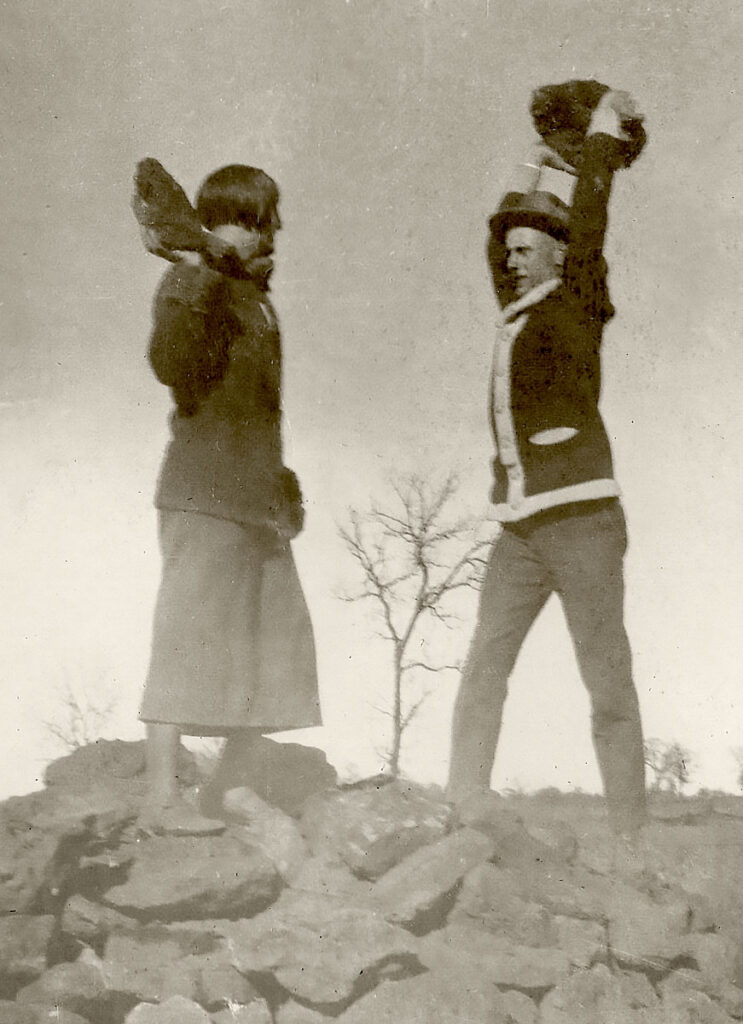
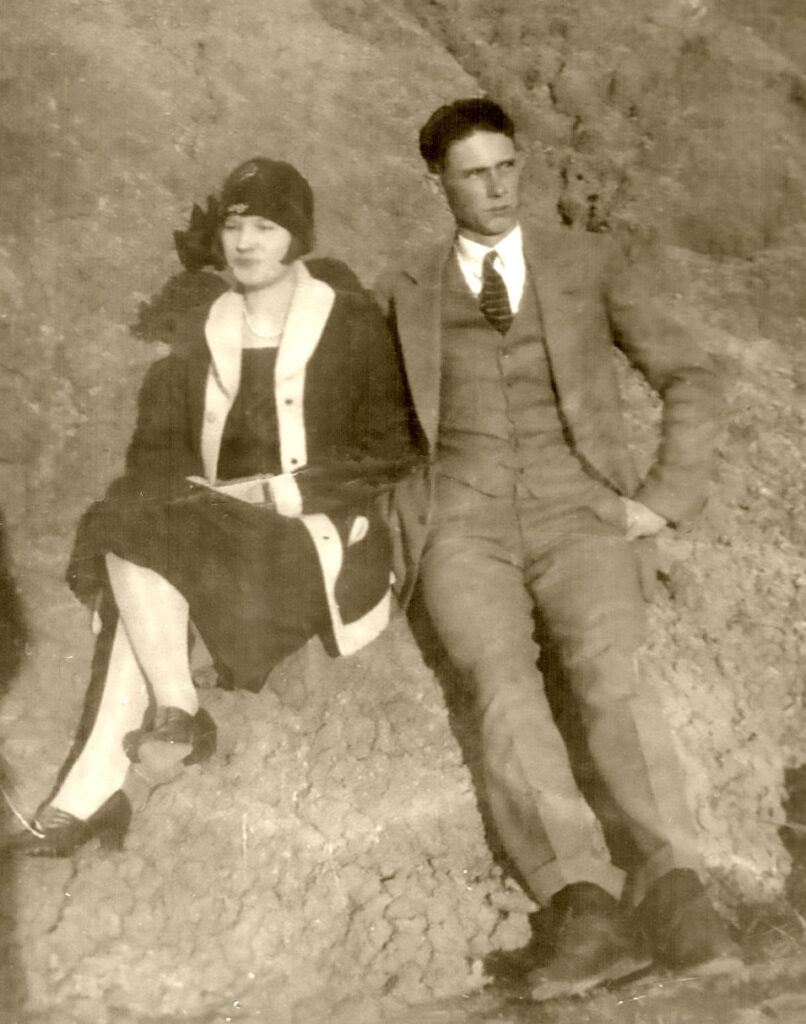
So, Ina became engaged to Bill, probably toward the end of 1926. We have six letters between them which have survived – five written by Bill and one by Ina — in the 3 months leading up to their wedding in 1927. By the time of the first letter, dated January 28, 1926, Bill had moved back to Strawn — so maybe his transfer and departure from Oklahoma precipitated a proposal. Ina’s boss, W.B. Buster Vaughan passed away in October 1926 and the store was liquidated soon after, so her life was in transition also — although we know from the letters that she continued to work up to the day of the wedding. I will put the letters here, so you can read for yourself. Bill definitely misses her and was anticipating the day when they would be together. They are not long and show the sweet banter between young star-crossed lovers.
The wedding was to be on Saturday night, April 30, 1927, in Paul’s Valley. Bill asked Ina if she could get off work at noon that Saturday, since it was her last workday anyway. Either she didn’t ask, or she asked and was denied, but she had to work until six pm the night of her wedding (which was at 7:00!). Wow!! Bill’s plan was to leave on Friday, the day before, and get as far as Fort Worth. Then he would drive the rest of the way to Paul’s Valley on Saturday, arriving early in the evening.
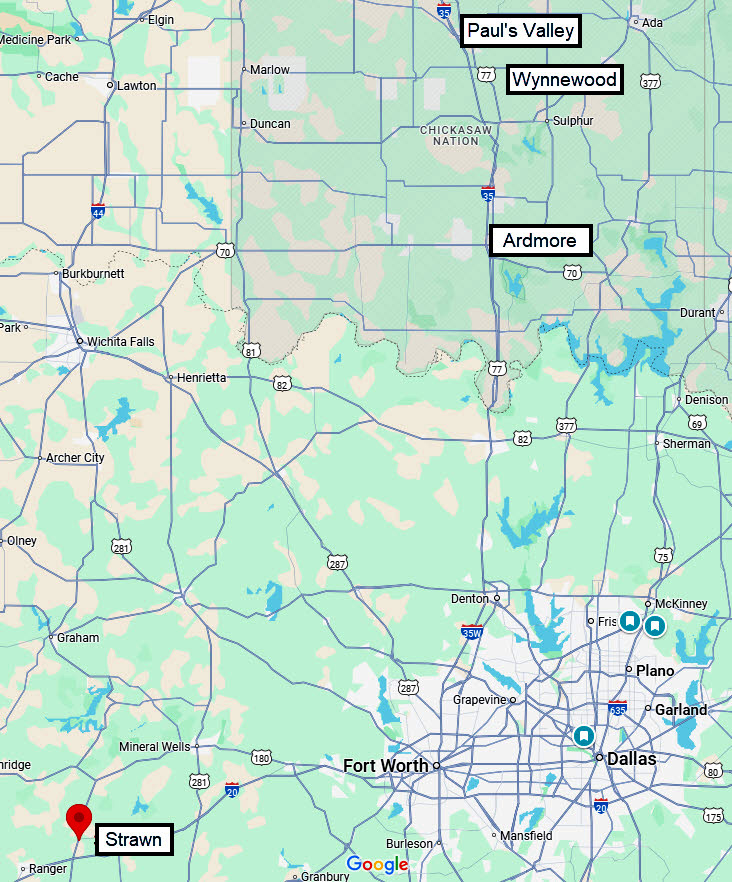
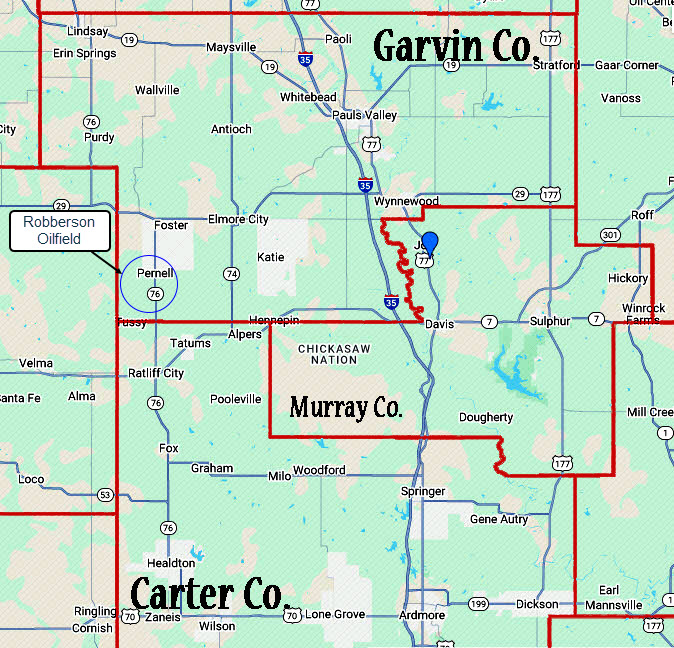
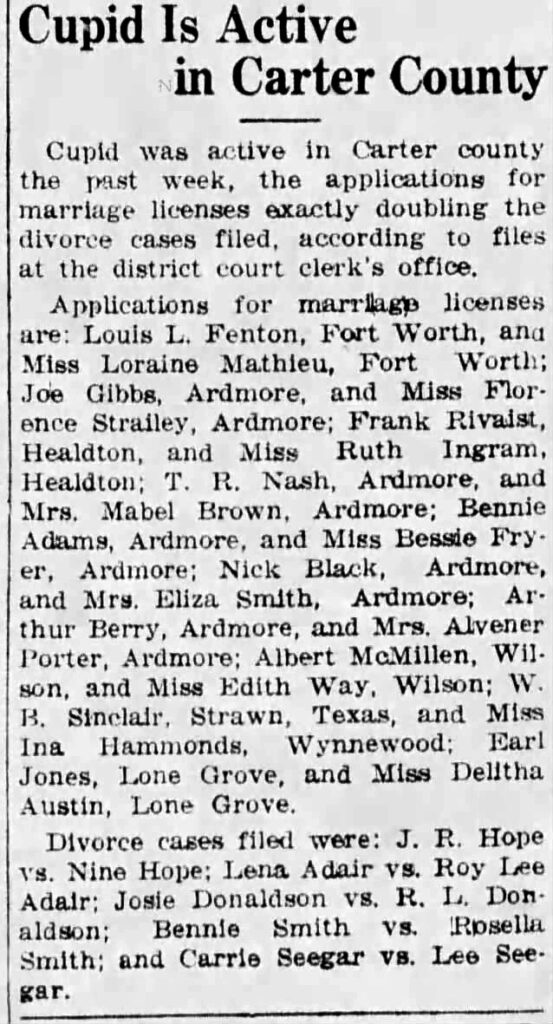
And he had to stop along the way to get a marriage license. The place he stopped turned out to be at Ardmore in Carter County, just to the south of Garvin County. It turns out that you don’t have to marry in the same county as the license is issued in Oklahoma — at least that is the law now and probably was back then also. The county seat of Garvin County is Paul’s Valley, where the wedding was to take place. However, it is possible that being late on a Saturday may have made the Carter County license a better option. Were county offices even open on Saturday back then? Must have been in Ardmore because the license was dated the 30th!
The wedding transpired as planned and by newspaper accounts, it was simple and lovely. No photos unfortunately, but we know from a letter that Ina had a special dress and Audry had pressed it. The ceremony was held in the Baptist parsonage in Paul’s Valley at 8:00 p.m. and was officiated by Rev. F.E. Cornelius. Bridesmaids were Audra Hopkins, Theresa Flynn, Ella Richardson, and Goldie Hammond, Ina’s little sister. Theresa and Ella signed as the witnesses. There is a certificate of marriage at the bottom of the license application stamped and approved dated April 30, 1927 and it is recorded in the Carter County Marriage Book on page 235. After the ceremony, the couple was to leave for either Ardmore or Fort Worth/Dallas before going onto their new home in Strawn.
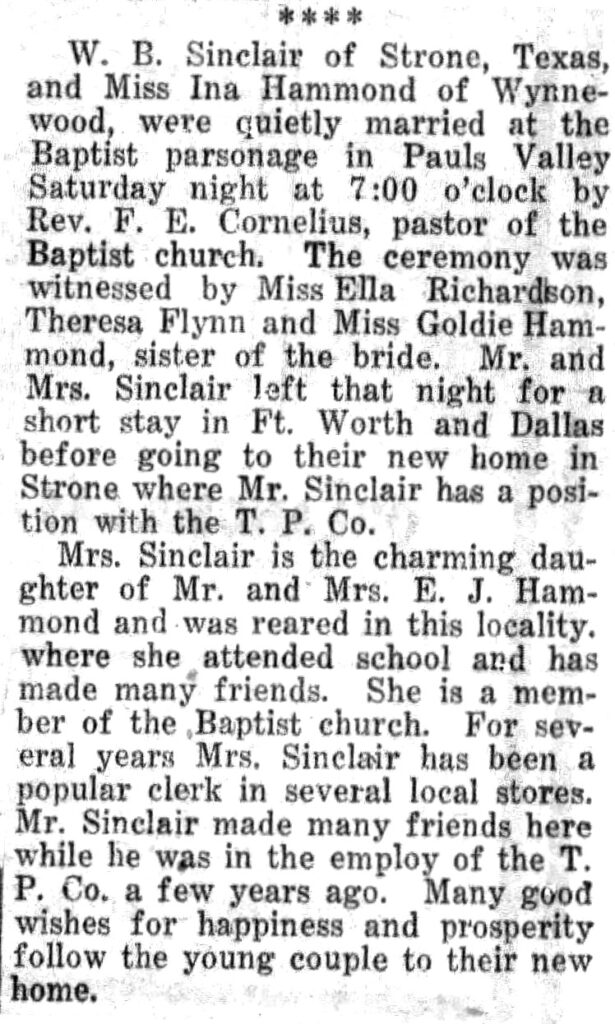
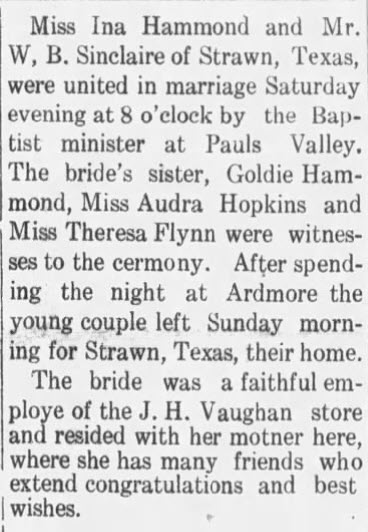
The two Wynnewood newspapers couldn’t agree on Ardmore or DFW for the honeymoon. But, the important thing is that the wedding went off without a hitch.
….Or did it?
Imagine my surprise when I found another marriage license and Certificate of Marriage, also obtained in Carter County, for William B Sinclair and Ina Hammond — this one dated May 9, 1927. Nine days later. This one has identical application information, but the ceremony is performed by a Christian minister at the Carter County Courthouse with the County clerk and Deputy County Clerk as the only witnesses. Of course, questions are swirling in my head. For some reason, the first marriage was not valid. They had to come all the way back to Oklahoma more than a week after the fact and repeat their vows — quickly and quietly in front of strangers– in the courthouse, no less!
What could have happened? Both certificates are recorded in the Carter County Marriage Book, the first on page 235 recorded May 3 and the second on page 245 recorded May 9. There is no “VOID” stamp on the first one to indicate it is not valid. The name of the pastor and the church listed on the initial certificate was R. A. Brigham at the First Christian Church. The newspaper reported the pastor was F.E. Cornelius at the Baptist Church. If the pastor/church discrepancy was the problem, couldn’t they have corrected this without invalidating the first certificate?
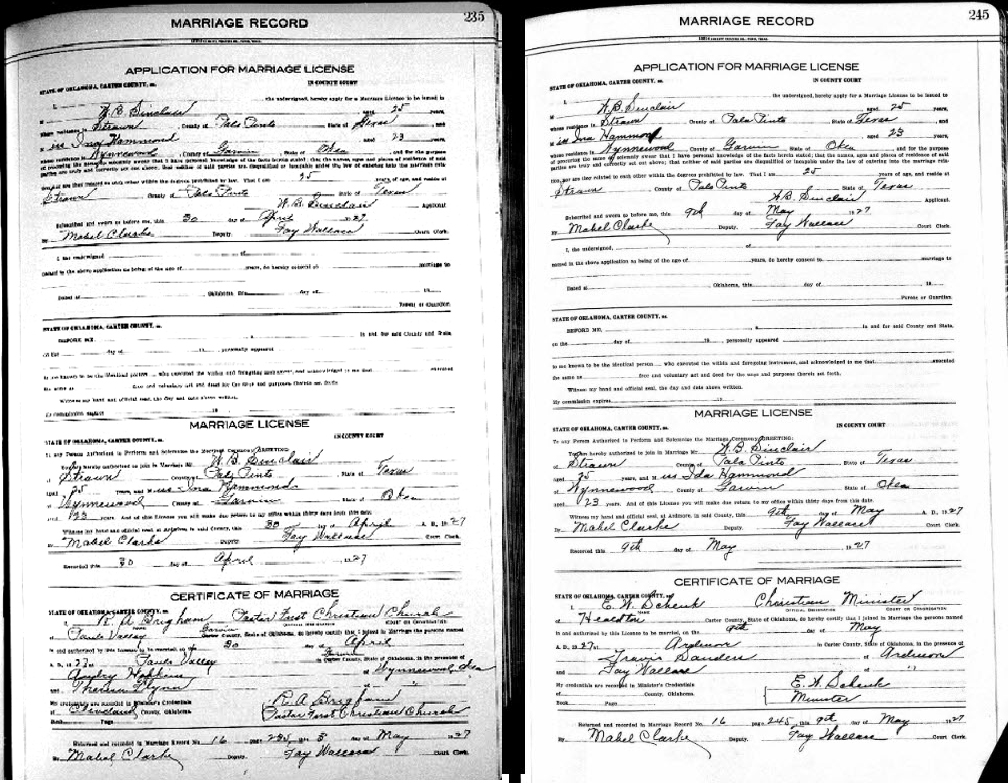
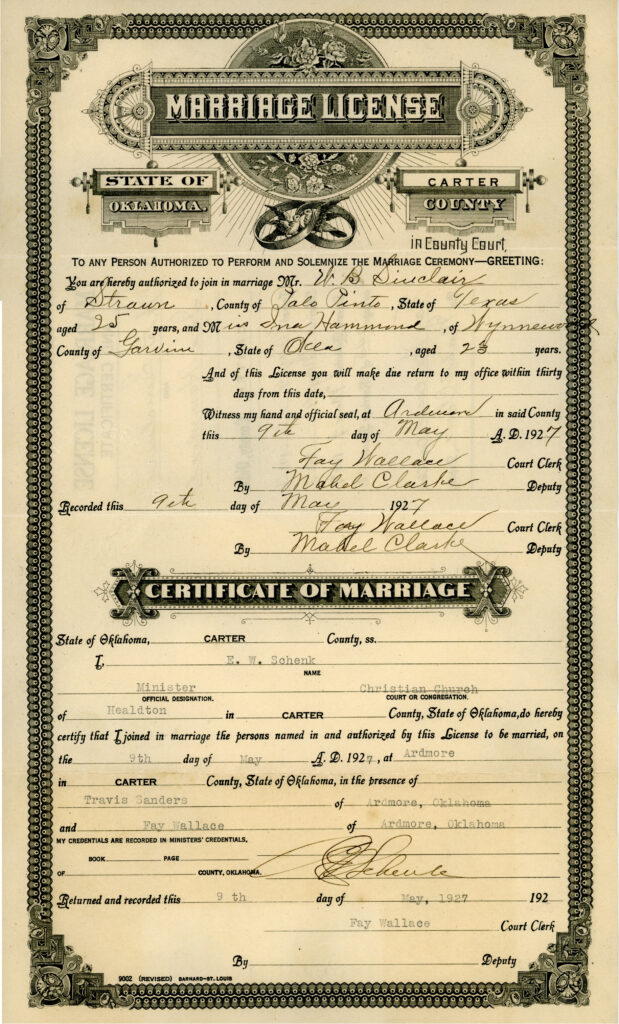
I asked my Aunt Ellen, who is Bill & Ina’s last surviving daughter. Certainly, this was one of those funny stories that got passed down and laughed about. Not so. Ellen said that her mother did finally reveal it late in her life as her deepest, darkest secret. She was acutely embarassed and didn’t think anyone else ever knew. Ina was mortified that she and Bill had “lived in sin” for a whole week. We don’t know how or when they found out about their predicament. Was it a phone call, a telegram, a letter? What does appear to be true is that Bill and Ina created a plausible cover story and went back to Oklahoma the next weekend.
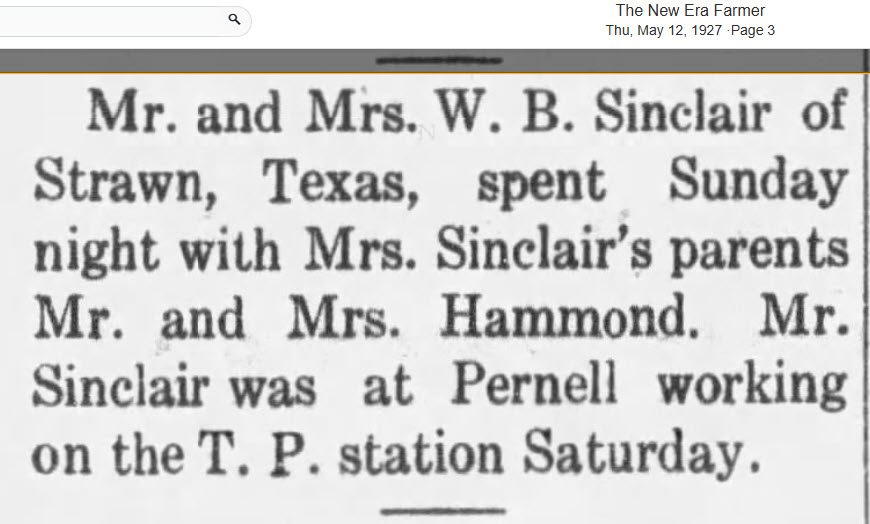
This blurb in the Wynnewood New Era Farmer of May 12 says that Mr. and Mrs. W.B. Sinclair spent the night with her parents on Sunday night (May 8) because Mr. Sinclair happened to be in the neighborhood working at nearby Pernell on Saturday. Hmm……..So maybe Bill really had work in Pernell — or maybe he didn’t. But that was their excuse for coming back the next weekend. Then, they got in their car on Monday morning, left her parent’s house, and stopped by the courthouse in Ardmore to quietly legalize their marriage before heading back to Strawn. And, I doubt that Ina’s parents ever knew. In our family, April 30, 1927 has always been the wedding date of Bill and Ina Sinclair. In fact, the tradition of an April 30 wedding date was carried on by daughter, Norma, and grand-daughter, Christi. But, lo and behold, buried deep in all the memorabilia we have a fancy certificate dated May 9th. So, if for any legal reason they had to report their wedding date, they would have had to say May 9, 1927, but, practically, they celebrated April 30 as their anniversary.
One treasure we still have from the “week they lived in sin” is the couple’s first grocery list jotted down in Ina’s distinctive script. It is written on a notepad from the Baker Hotels and dated May 2, 1927 (Monday). They might have spent a honeymoon night at the very posh Texas Baker Hotel in Fort Worth or the one in Mineral Wells. The list is full of staples like flour, sugar, butter, and baking powder – along with an ice pick, scissors, starch and bluing for laundry. There are 32 items on the list and the accompanying cash register receipt has 32 items in the addition. No impulse items for this thrifty couple! The name “Watson Grocery Co” is written at the top of the list and I’ve wondered about that. The Watsons were a founding family of Strawn, and they had a large dry goods and grocery store on the main street, the Watson Brothers Dry Goods and Mercantile. Bill and Ina were planning to make their first home at the Hohhertz Oilfield Camp near Strawn, and already had a house assigned to them. And, to get to the Hohhertz camp from Mineral Wells, one does have to go almost right into Strawn…..
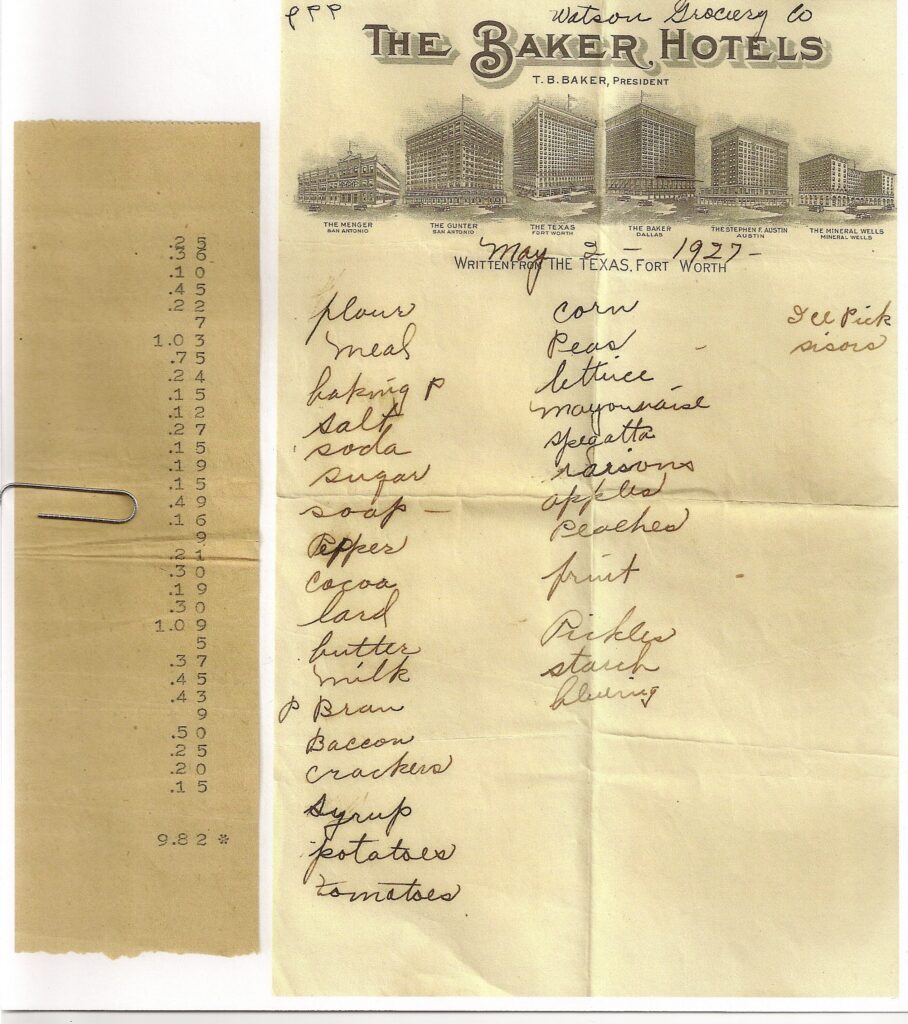
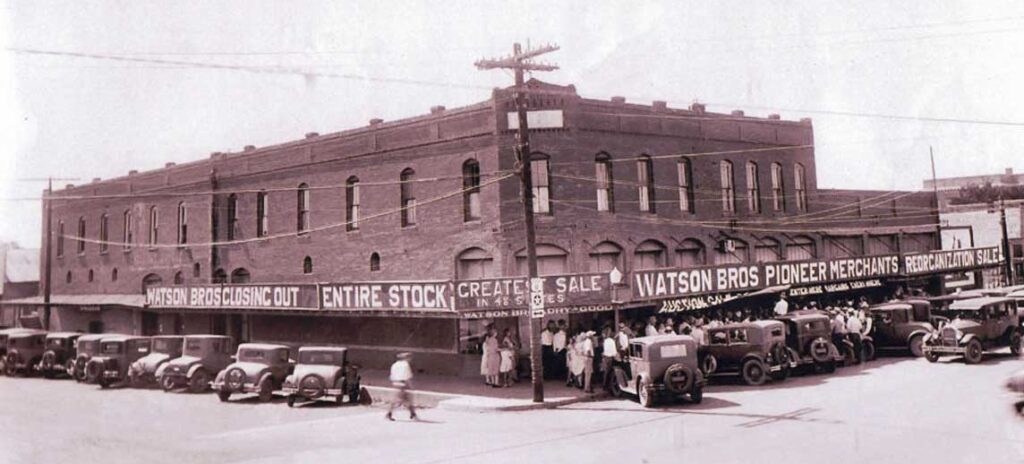
Don’t forget to read the letters. Click here.
